Abstract
Pigmented oranges are a high value typical product, used for the production of healthy juice-based drinks due to the peculiar presence of anthocyanins as dietary antioxidants. A qualitative HPLC/PDA/MS analytical method for verifying presence/absence of blood orange anthocyanins was validated in accordance with Eurachem guide in terms of accordance (100%), specificity/selectivity, repeatability of retention time (CV < 0.5%), limit of detection (0.36 mg/L) and limit of decision (0.41 mg/L). Fifty commercial red orange juice beverages were collected on the market and analyzed to assess the occurrence of blood orange anthocyanins. The results showed that only 60% of analyzed products have a minimum content of anthocyanins of blood orange, guaranteeing the specifications of the product they publicize and sell until the expiration date. Therefore, it is possible to envisage a gradual degradation of the specific parameter (anthocyanins) or willful misconduct of producers (non-use of blood orange juice). In both cases, the consumer buys a product with high added value without such value being guaranteed. This information will be useful to revise the expiration date of these products, the percentage of blood orange juice used in the preparation and/or the storage conditions of the products.
1. Introduction
Flavonoids are the most abundant phenolic compounds present in Citrus fruit. Flavonoids may be further divided into subclasses: anthocyanidins, flavanols, flavanones, flavonols, flavonones and isoflavones. Flavonoids connected to one or more sugar molecules are known as flavonoid glycosides, while those that are not connected to a sugar molecule are called aglycones. Flavonoids occur in plants and most foods as glycosides [1,2]. Flavanone glycosides predominate, together with small but distinctive other flavonoids such as methoxylated flavones, anthocyanins and flavones glycosides [3]. The literature shows some interest in Citrus flavonoids because of their potential health benefits and their use as a tool for chemotaxonomic markers [4,5,6,7,8,9].
Citrus sinensis varieties Moro, Tarocco and Sanguinello, also known as blood oranges and typically grown in the Etna volcano region of Sicily (Italy) as well as in Florida (USA), are the unique Citrus fruit containing anthocyanins responsible for their brilliant red colour [10]. Anthocyanins are based on the anthocyanidin skeleton, which has extra unsaturation in the C ring forming the pyrylium system (Table 1). Anthocyanidins are not stable due to the -OH group at the C-3 position and are found in nature with a sugar linkage at this position. Cyanidin 3-glucoside (C3G) and cyanidin 3-(6”-malonyl)-β-glucoside (C3-6MG) [4] are the main components of the blood oranges, together with a dozen of minor constituents [10]. Furthermore, such studies have shown that the C3-6MG is present in a concentration rather high in freshly squeezed juices, but it easily hydrolyses to C3G in processed and stored juices. Literature reports that anthocyanin content in fruits is depending on several abiotic conditions, month of harvest and cultivar [11,12]. In particular, all blood orange varieties require strong day-night thermal climes for intense color formation in fruit flesh, and varieties such as Moro, with the potential for high pigmentation, are strongly dependent on the prevailing climatic conditions during fruit ripening for full color development [13].

Table 1.
Main anthocyanins of pigmented Citrus cultivars.
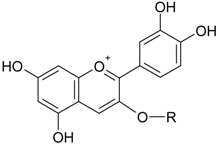 | |
| Name | R |
| Cyanidin-3-β-glucoside | Glucose |
| Cyanidin-3-(6”-malonyl)-β-glucoside | Malonyl-Glucose |
Due to the growing interest in the presence of pharmacologically active components in food products, the demand for blood orange juice is arising, and an increasing diffusion of red orange juice based drinks is spreading on the market. Because of its high cost, the red dye is often achieved by the addition of natural and synthetic dyes (black carrot, red berries, carminic acid, allura red, etc.), reducing the amount of blood orange juice in the final product even up to its non-use as ingredient.
The soft-drink market offers different kinds of products containing blood orange juice at different concentration (0.5% to 100%), because the labeling legislation does not impose a limit below which it is possible to use blood oranges nor a minimum anthocyanins content. Nevertheless, the date of minimum durability of a foodstuff is defined in Council Directive 2000/13/EC [14] on the labeling, presentation and advertising of foodstuffs as the date until which a foodstuff retains its specific properties when properly stored. Therefore, in the interest of consumers should be guaranteed a minimum content of the blood orange anthocyanins (specific property of this type of fruit) for the entire commercial duration of a product.
Many studies report the analysis of blood orange juice anthocyanins by HPLC with spectrophotometric detection [15], but recently the electrospray mass spectrometry (ESI/MS) has proven to be a very effective tool for their characterization and unambiguous identification [1,10]. The hyphenated technique of HPLC coupled with photo diode array (PDA) spectrophotometers and soft electrospray ionization (ESI) with tandem mass spectrometry is the approach most recently used for the characterization of polyphenolic fruits profile [16,17,18,19].
In the frame of control activity made from Central Inspectorate for Quality Control of Agricultural and Food Productions, a qualitative HPLC/PDA/MS analytical method was developed and validated and several red orange beverage were collected on the market (Figure 1) and analyzed by to assess the occurrence of blood orange specific anthocyanins, in order to preserve consumers from commercial illicit and safeguard honest manufacturers.
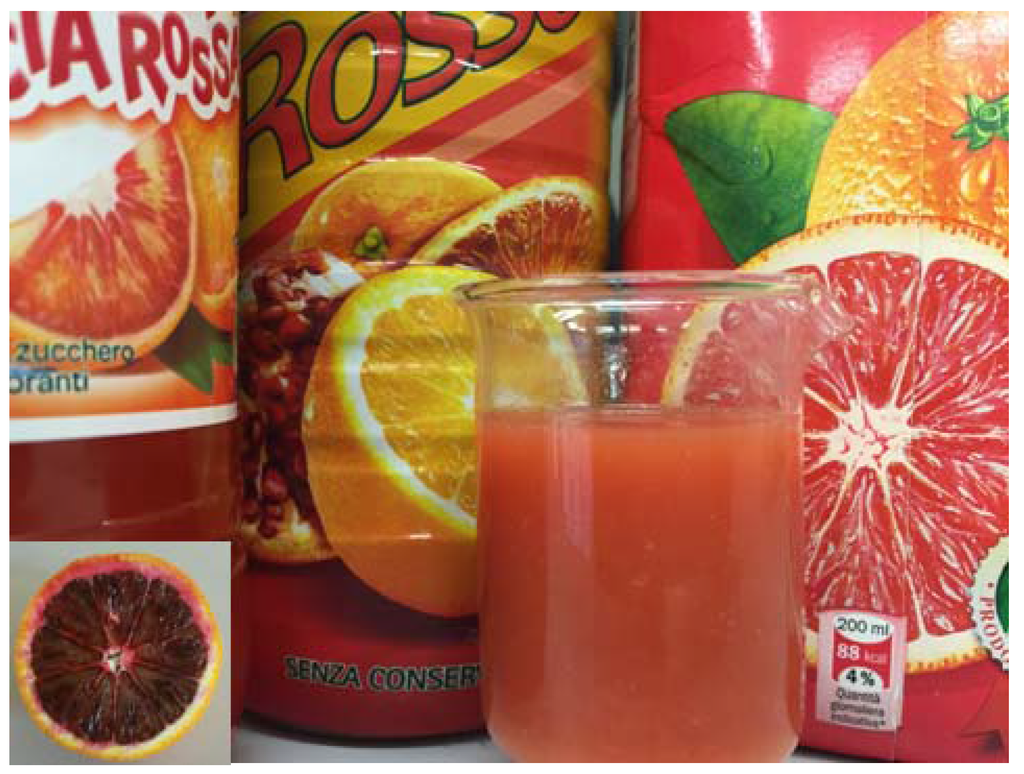
Figure 1.
Example of analyzed samples.
2. Materials and Methods
2.1. Chemicals
Cyanidin-3-O-glucoside chloride (purity ≥ 96%) was obtained by Extrasynthese (Genay, France). HPLC-grade acetonitrile was supplied by Romil (Milan, Italy), analytical grade formic acid were by VWR International (Milan, Italy). Distilled water was purified at 18.2 MΩ with a Millipore MilliQ ULTRA (Milan, Italy) purification system.
2.2. Chromatographic Analyses
The analyses were performed with a liquid chromatograph consisting of a Finnigan Surveyor MS-pump, autosampler and photodiode-array detector (PDA), coupled with a Finnigan LCQ DECA XP MAX detector (Thermo Fisher Scientific, San Jose, CA, USA). The analytical column was an Aquasil C18 150 × 2.1 mm, i.d. 3 μm (Thermo Fisher Scientific), the flow rate was 200 µL/min, the column temperature 30 °C and the injection volume 10 µL. A binary gradient of 0.3% formic acid in water (A) and 0.3% formic acid in acetonitrile (B) was employed. The mobile phase gradient was programmed as follows: 0 min, 5% B; 50 min, 28% B; 60 min, 43% B; 60–65 min, 43 % B; 70–80 min, 5% B. The range of wavelengths examined by the photodiode-array detector was 200–750 nm. Mass spectral analyses were performed using a LCQ ion-trap mass operating in positive ion mode using an ion spray LC/MS interface. The electrospray ionization (ESI) needle voltage was 3.5 kV. The capillary voltage was 18 V and the heated capillary was 250 °C. A sheath gas flow rate of 36 (arbitrary units) was used and the auxiliary gas was set to 12 (arbitrary units). The MS-MS spectra were obtained using collision energy of 27% of instrument maximum, operating in Product Ion Scan Mode (parent ions: 449 ± 3 u and 536 ± 3 u). The mass scan range was 145–1600 m/z. The MS/MS spectra were determined on the basis of the fragmentation of the ions at m/z 449 ± 3 u (C3G) at m/z 536 ± 3 u (C3-6MG). The chromatographic profiles were recorded at λ 280 nm for flavanones, at λ 335 for flavones and λ 520 nm for anthocyanins respectively. The identification of analytes peaks was performed by comparison of the retention time, the spectroscopic characteristics and mass spectra with the working standard solution of C3G and with a sample of fresh squeezed blood orange juice (Figure 2).
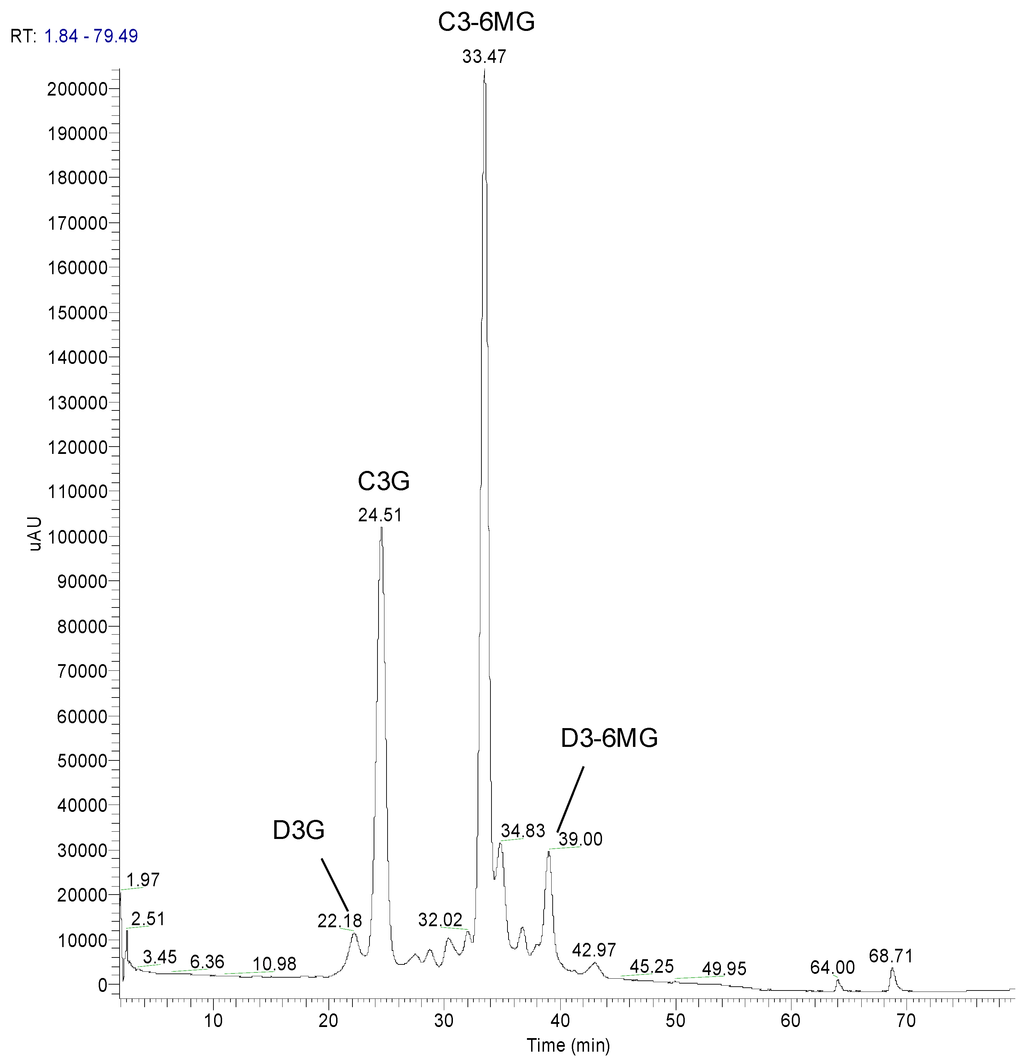
Figure 2.
Anthocyanins profile of fresh squeezed blood orange juice: delphinidin 3-glucoside (D3G), cyanidin 3-glucoside (C3G), cyanidin 3-(6”-malonyl)-glucoside (C3-6MG), delphinidin 3-(6”-malonyl)-glucoside (D3-6MG).
2.3. Validation Parameters
The developed method was statistically validated in accordance with the European Commission criteria and the CITAC/Eurachem [20] guidelines for qualitative analytical methods as follows:
2.3.1. Accordance
Precision is the closeness of agreement between independent test results obtained under predetermined conditions expressed in terms of imprecision/standard deviation of test results (quantitative methods). In qualitative methods the precision is calculated as accordance.
Accordance is calculated by 10 independent analysis of a blank samples spiked at concentrations of analyte next to limit of decision CCα (orange juice beverage spiked with 1% of blood orange juice at C3G concentration of 53 mg/L).
where PA is positive agreement (samples resulting positive at the analysis) and N+ true positive (N+ = 10; spiked samples analyzed).
Accordance (%) = 100 × PA/N+
2.3.2. Specificity/Selectivity
Specificity/selectivity is defined as the ability of a method to distinguish between analyte being measured and other substances that could give problem of interference.
For specificity/selectivity studies, 20 different blank samples and 20 positive samples with interfering substances at a relevant concentration (blood orange beverages containing other red ingredients/additives such as black carrot extract (n = 4), black currant extract (n = 4), E120 (n = 3), E122 (n = 3), E124 (n = 3), E129 (n = 3) were analyzed with in Photo Diode Array and in Mass Spectrometer.
Specificity was evaluated as follows:
where NA is negative agreement (samples resulting negative at the analysis) and N− true negative (N− = 20; black samples analyzed).
Specificity (%) = 100 × NA/N−
2.3.3. Repeatability in Retention Times
The analyses were carried out on standard and on C3G fortified orange beverages (n = 10) and repeatability of retention time was expressed as coefficient of variation (CV%).
2.3.4. Method limit of decision (CCα) and limit of detection (CCβ).
In order to calculate CCβ and CCα for C3G presence in blood orange juice beverages, 10 different blank materials (anthocyanins free orange juice beverages) fortified with C3G at CCα were analyzed and:
where SD is the standard deviation on the detected signals, expressed as mg/L.
CCα = 1.6 × SD
CCβ = 3.3 × SD
2.4. Samples
A total of 50 samples of commercial red colored beverages containing blood orange juice as ingredient (10 samples with labeled blood orange juice from 0.5% to 1%, 10 samples with labeled blood orange juice from 2% to 5%, 10 samples with labeled blood orange juice from 10% to 20%, 20 samples with labeled blood orange juice from 20% to 35%) were collected in Italy during the years 2013–2014. The pick up was made in four aliquots by Ministry of Agricultural Alimentary and Forestry Policies (MIPAAF) officers. An official report was written up for every sample. The samples were labelled with a description of the pick-up location, pick-up date, sample typology and origin, and sent to ICQRF Catania Laboratory for the analyses. Before HPLC/PDA/MS analyses, sample was sonitated for 5 min (only sparkling beverages) and centrifuged at room temperature at 3000 rpm with an ALC 4236 centrifuge (Italy). After filtration with 0.45 µm PTFE filter (VWR, Italy) the samples were directly analyzed. The analyses were conducted in duplicate.
3. Results and Discussion
Studies in the literature have shown that different phenolic components can be used as chemotaxonomic markers for citrus fruits. Flavonoids narirutin, hesperidin and didimin are characteristic of all the oranges and may be used in the control of beverages containing orange juice as an ingredient. More specific to discriminate the blood orange juice employ is the distribution of hydroxy cinnamic acid [21], of volatile compounds [22] and fatty acids [23] as well as the aminoacids distributions [24]. However, all these parameters may not be used as unique markers to the identification of red orange juice in fruit beverages, where the percentage of orange is reduced significantly compared to the 100% juice. Moreover the complexity of ingredients such as presence of other juices and different colorant additives or aromas, makes difficult to apply for the purposes of quality control assessment. Therefore the anthocyanin profile has been considered in this study to be the only compositional markers that could be used in these kinds of matrixes in order to detect the presence of blood orange juice.
In order to detect anthocyanins profile in red orange beverages, the HPLC/PDA/MS analytical method proposed by Dugo et al. [10] for orange juices was modified to better resolve the different ingredients utilized in beverages manufacture. Under the chromatographic conditions described in the materials and methods section, the C3G and C3-6MG were separated and well recognizable on the basis of UV-vis spectra and fragmentation pattern of the parent ions. The spectroscopic characteristics of both analytes were in agreement with the literature data [1,10]. Maximum UV-Vis absorption of C3G and C3-6MG was at 520nm and anthocyanins positive MS spectrum produces an intense quasi molecular ion [M]+. MS/MS data obtained by the fragmentation of anthocyanins permit the detection of the corresponding anthocyanidin [A]+, accordingly with the loss of the sugar moiety and the production of the positively charged aglycon (Figure 3).
3.1. Method Validation
Qualitative analysis, instead of quantitative analysis, is recommended primarily at analyte concentrations near to the limit of detection [20]. On the basis of experimental design the results are summarized as follows:
3.1.1. Accordance
A qualitative analysis involves identification or classification of substances and is effectively a “yes”/“no” answer at a given cutoff concentration of an analyte. For qualitative methods, precision cannot be expressed as a standard deviation or relative standard deviation, but may be expressed as true and false positive and negative rates. The experimental results provide an accordance judgments about the authenticity of the sample equal to 100%.
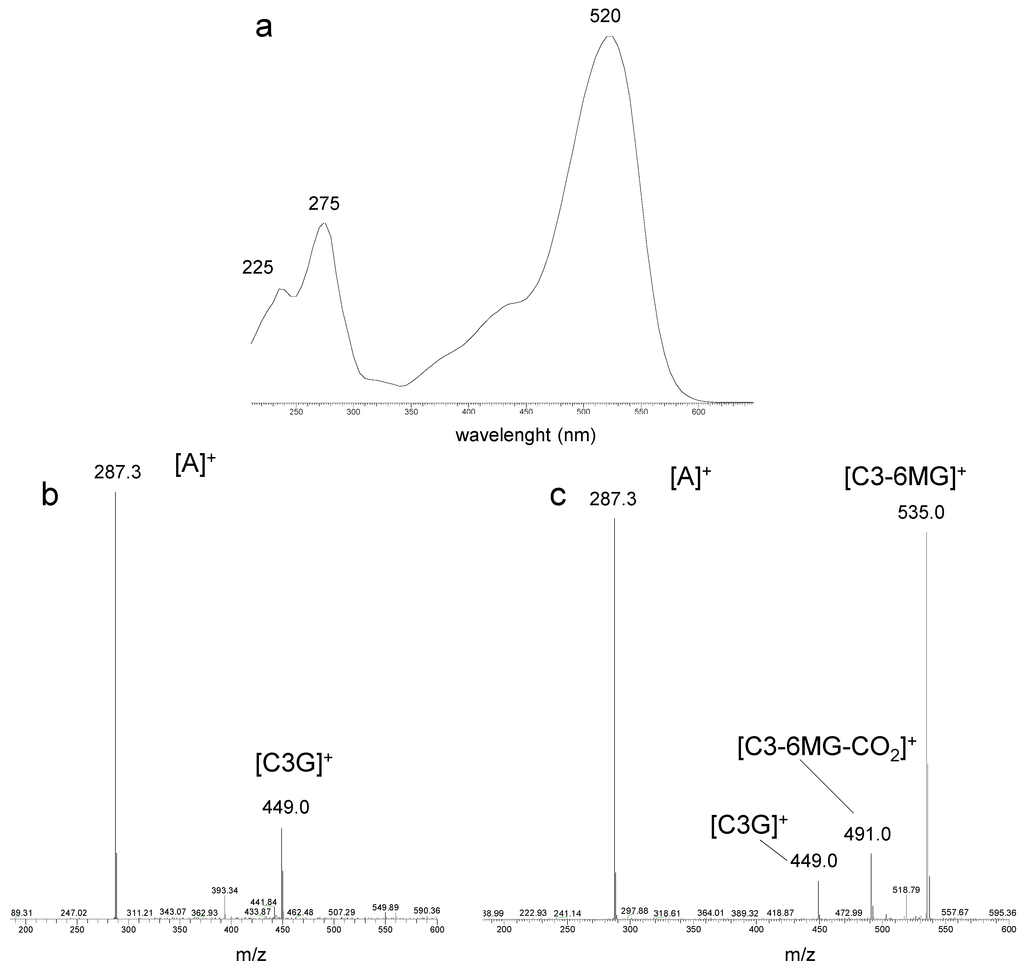
Figure 3.
UV-Vis spectrum (a) and positive ESI/MS-MS fragmentation pattern of cyanidin 3-glucoside (C3G) (b) and cyanidin 3-(6”-malonyl)-glucoside (C3-6MG) (c). Cyanidin Aglycon [A].
3.1.2. Specificity/Selectivity
The comparison analysis between the anthocyanins-free orange juice beverage and red orange beverages containing other red ingredients showed specificity of 60% by using Photo Diode Array detection at λ 520 nm. No interference was found in the UV-Vis chromatograms in samples containing the red dyes E120 (Figure 4), E122, E124 and E129. On the contrary, blood orange juice beverage containing black carrot (Figure 4) and black currant extracts, interferes in the UV-Vis spectra due to the presence of a foreign anthocyanin pattern (cyanidin 3-xylosylgalactoside, sinapic acid derivative of cyanidin 3-xylosylglucosylgalactoside, ferulic acid derivative of cyanidin 3-xylosylglucosylgalactoside and coumaric acid derivative of cyanidin 3-xylosylglucosylgalactoside in black carrot and cyanidin-3-rutinoside, delphinidin-3-glucoside and delphinidin-3-rutinoside in black currant) giving false negative results and decreasing specificity. By using mass spectrometer detector, these false identifications are removed and the specificity rise to 100%.
In these cases the detection by mass spectrometry detector becomes of fundamental importance for the assessment of compliance.
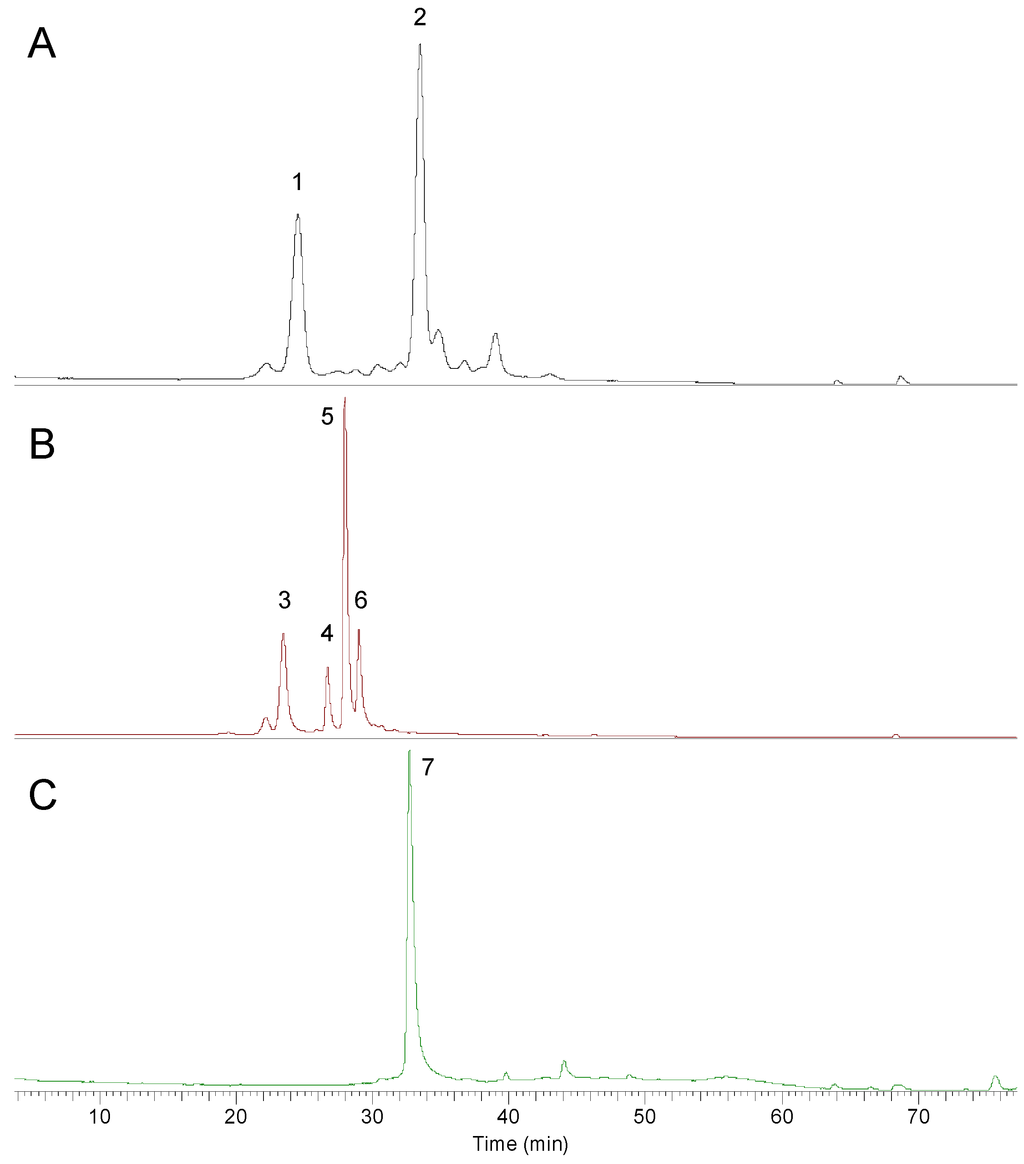
Figure 4.
Chomathograms at 520 nm of: blood orange juice (A), black carrot red extract (B) and carmine additive E120 (C). Cyanidin 3-glucoside (1), cyanidin 3-(6”-malonyl)-glucoside (2), cyanidin 3-xylosylgalactoside (3), sinapic acid derivative of cyanidin 3-xylosylglucosylgalactoside (4), ferulic acid derivative of cyanidin 3-xylosylglucosylgalactoside (5), coumaric acid derivative of cyanidin 3-xylosylglucosylgalactoside (6), carminic acid (7).
3.1.3. Repeatability in Retention Times
Repeated analyses carried out on standard and on fortified C3G beverages showed a coefficient of variation on the retention times <0.5%.
3.1.4. Method limit of decision (CCα) and limit of detection (CCβ).
For screening purposes, the European Commission Decision 2002/657/EC specifies that only those analytical techniques for which validity can be demonstrated and have a false compliant rate of <5% at the level of interest shall be used. High throughput and a low percentage of false compliant (false negative) results are the main criteria for screening methods, requiring a value for CCβ (detection capability) below the minimum required performance limit (MRPL). The ideal screening method, therefore, combines these criteria with a low percentage of false noncompliant (false positive) results, but this reflects more the economics of laboratory testing and not the principle of screening, the only purpose being to sift out the “noncompliant” samples from a large population. Detection capability (CCβ) is the smallest content of the substance that may be detected, identified and/or quantified in a sample with an error probability of β. In MRPL, CCβ is the lowest concentration at which the method is able to detect an analyte in a sample with a statistical certainty of 1 − β (β = 0.05). Decision limit (CCα) is the lowest concentration level at which a method can discriminate with a statistical certainty of 1 − α (α=0.05) that the particular analyte is present.
Despite the very low instrumental limit of detection of 0.05 mg/L for C3G, this study has determined the limits of the method, taking into account matrix effects. The values obtained are the following:
- CCα: 0.36 mg/L;
- CCβ: 0.41 mg/L.
Because the C3-6MG in processed and stored juices and beverages easily hydrolyses to C3G, the judgment about the presence of blood orange juice is expressed according to the following criteria:
- the presence of blood orange juice in the analyzed sample is confirmed if the amount of cyanidin 3-glucoside >CCα;
- the absence of blood orange juice in the analyzed sample is established if the amount of cyanidin 3-glucoside <CCα.
3.2. Assessment of C3G Occurrence on Commercial Red Orange Fruit Beverages
Analysis carried out on 50 commercial samples of red orange fruit beverages showed that 60% of commercial products have a minimum content of anthocyanins of blood oranges, guaranteeing the specifications of the product they publicize and sell until the expiration date. Although the concentration range of red orange juice declared on the label is very variable, correlation between the presence of anthocyanins and the stated % has not been found. All analyzed samples were found to contain typical sweet orange flavanones narirutin, hesperidin and didimin, and 6,8-C-glucopyranosylapigenin among flavone glycosides.
Literature data on blood orange pure juices reported a possible degradation of pigments with storage that could be justified the absence of C3G [26,27,28] in the other 40% of the analyzed samples. Therefore, it is possible to envisage a gradual degradation of the specific parameter (anthocyanins) or willful misconduct of producers (non-use of blood orange juice). In both cases, the consumer buys a product with high added value without such value is guaranteed. Even assuming the producer’s good faith in the fact that it claims to have used blood oranges, the healthy characteristics of the product does not remain throughout its shelf life, creating consumer of “first class” (those who buy the product just produced) and consumers of “second class” (those who buy it to maturity, without part of its healthy features).
4. Conclusions
This study has demonstrated the requirement of the use of photo diode array coupled by tandem mass spectrometry for C3G detection when the blood orange juice is used as ingredient in beverages, limiting together the UV-Vis interference due to other natural dyes used in the preparation such as black carrots or red berries. The sensitivity achieved with HPLC/PDA/ESI/MS-MS method makes it adequate for the purposes.
Analysis carried out on commercial samples evidenced that just over half of the blood juice beverages has a minimum anthocyanins content as healthy parameter advertised on the label. These evidences are not in accordance with the indications of the Council Directive 2000/13/EC [14] regarding the minimum durability of foodstuff products which must preserve their specific properties for the entire shelf life. In order prevent misleading advertising, the manufacturer should evaluate the shelf life of the product depending on the ingredients used, their concentration and their durability.
Author Contributions
M.S., M.G., P.T. and G.G. conceived and designed the experiments. F.L. and M.-A.B performed the experiments. M.S. and L.S. analyzed the data and wrote the manuscript.
Conflicts of Interest
The authors declare no conflict of interest.
References
- Scordino, M.; Sabatino, L. Characterization of polyphenolic profile of Citrus fruit by HPLC/PDA/ESI/MS-MS. In Polyphenols in Plants: Isolation, Purification and Extract Preparation; Watson, R.R., Ed.; Academic Press: London, UK, 2014; pp. 187–199. [Google Scholar]
- Tripoli, E.; La Guardia, M.; Giammanco, S.; di Majo, D.; Giammanco, M. Citrus flavonoids: Molecular structure, biological activity and nutritional properties: A review. Food Chem. 2007, 104, 466–479. [Google Scholar] [CrossRef]
- Horowitz, R.M. The Citrus flavonoids. In The Orange: Its Biochemistry and Physiology; Sinclair, W.B., Ed.; University of California Press: Berkeley, CA, USA, 1961; pp. 334–372. [Google Scholar]
- Maccarone, E.; Rapisarda, P.; Fanella, F.; Arena, E.; Mondello, L. Cyanidin 3-(6”-malonyl)-β-glucoside. One of the major anthocyanins in blood orange juice. Ital. J. Food Sci. 1998, 10, 367–372. [Google Scholar]
- Gattuso, G.; Barreca, D.; Gargiulli, C.; Leuzzi, U.; Caristi, C. Flavonoid composition of Citrus juice. Molecules 2007, 12, 1641–1673. [Google Scholar] [CrossRef] [PubMed]
- González-Molina, E.; Domínguez-Perles, R.; Moreno, D.A.; García-Viguera, C. Natural bioactive compounds of Citrus limon for food and health. J. Pharm. Biomed. Anal. 2010, 51, 327–345. [Google Scholar] [CrossRef] [PubMed]
- Scordino, M.; Sabatino, L.; Belligno, A.; Gagliano, G. Flavonoids and furanocoumarins distribution of unripe Chinotto (Citrus × myrtifolia Rafinesque) fruit: Beverage processing homogenate and juice characterization. Eur. Food Res. Technol. 2011, 233, 759–767. [Google Scholar] [CrossRef]
- Scordino, M.; Sabatino, L.; Traulo, P.; Gargano, M.; Pantó, V.; Gagliano, G. HPLC/PDA/ESI-MS/MS detection of polymethoxylated flavonoids highly degraded citrus juice: A quality control case study. Eur. Food Res. Technol. 2011, 232, 275–280. [Google Scholar] [CrossRef]
- Hwang, S.L.; Shih, P.H.; Yen, G.C. Neuroprotective effects of Citrus flavonoids. J. Agric. Food Chem. 2012, 60, 877–885. [Google Scholar] [CrossRef] [PubMed]
- Dugo, P.; Mondello, L.; Morabito, D.; Dugo, G. Characterization of the anthocyanins fraction of sicilian blood orange juice by micro-HPLC-ESI/MS. J. Agric. Food Chem. 2003, 51, 1173–1176. [Google Scholar] [CrossRef] [PubMed]
- Dannehl, D.; Josuttis, M. Cultivar and production effects on bioactive polyphenols. In Polyphenols in Plants: Isolation, Purification and Extract Preparation; Watson, R.R., Ed.; Academic Press: London, UK, 2014; pp. 3–13. [Google Scholar]
- Gómez-Caravaca, A.M.; Verardo, V.; Segura-Carretero, A.; Fernández-Gutiérrez, A.; Caboni, M.F. Phenolic compounds and saponins in plants grown under different irrigation regimes. In Polyphenols in Plants: Isolation, Purification and Extract Preparation; Watson, R.R., Ed.; Academic Press: London, UK, 2014; pp. 37–52. [Google Scholar]
- Butelli, E.; Licciardello, C.; Zhang, Y.; Liu, J.; Mackay, S.; Bailey, P.; Reforgiato-Recupero, G.; Martin, C. Retrotransposons control fruit-specific, cold-dependent accumulation of anthocyanins in blood oranges. Plant Cell 2012, 24, 1242–1255. [Google Scholar] [CrossRef] [PubMed]
- Council Directive 2000/13/EC. Labelling, Presentation and Advertising of Foodstuffs. Available online: http://europa.eu/legislation_summaries/consumers/product_labelling_and_packaging/l21090_en.htm (accessed on 19 May 2015).
- Rapisarda, P.; Fanella, F.; Maccarone, E. Reliability of analytical methods for determining anthocyanins in blood orange juices. J. Agric. Food Chem. 2000, 48, 2249–2252. [Google Scholar] [CrossRef] [PubMed]
- Song, J.; Li, X.; Zeng, L.; Liu, H.; Xie, M. Determination of cyanidin-3-glucoside (red kernel food colour) in beverages by high performance liquid chromatography and a study of its degradation by quadruple time-of-flight mass spectrometry. Food Addit. Contam. Part A Chem. Anal. Control Expo. Risk Assess. 2011, 28, 1645–1656. [Google Scholar] [PubMed]
- Fabre, N.; Rustan, I.; Hoffmann, E.; Quetin-Leclercq, J. Determination of flavone, flavonol, and flavanone aglycones by negative ion liquid chromatography electrospray ion trap mass spectrometry. J. Am. Soc. Mass Spectrom. 2001, 12, 707–715. [Google Scholar] [CrossRef] [PubMed]
- Abad-García, B.; Berrueta, L.A.; Garmón-Lobato, S.; Gallo, B.; Vicente, F. A general analytical strategy for the characterization of phenolic compounds in fruit juices by high performance liquid chromatography with diode array detection coupled to electrospray ionization and triple quadrupole mass spectrometry. J. Chromatogr. A 2009, 1216, 5398–5415. [Google Scholar] [CrossRef] [PubMed]
- Simirgiotis, M.J.; Silva, M.; Becerra, J.; Schmeda-Hirschmann, G. Direct characterization of phenolic antioxidants in infusions from four Mapuche medicinal plants by liquid chromatography with diode array detection (HPLC-DAD) and electrospray ionization tandem mass spectrometry (HPLC-ESI–MS). Food Chem. 2012, 131, 318–327. [Google Scholar] [CrossRef]
- Magnusson, B.; Örnemark, U. Eurachem Guide: The Fitness for Purpose of Analytical Methods: A Laboratory Guide to Method Validation and Related Topics, Second Edition. Available online: http://www.eurachem.org/images/stories/Guides/pdf/MV_guide_2nd_ed_EN.pdf (accessed on 19 May 2015).
- Di Mauro, A.; Passerini, A.; Rapisarda, P.; Maccarone, E. Distribution of hydroxycinnamic acids as a criterion to evaluate variety and geographical origin of Italian orange juices. Ital. J. Food Sci. 2002, 14, 301–315. [Google Scholar]
- Maccarone, E.; Campisi, S.; Fallico, B.; Rapisarda, P.; Sgarlata, R. Flavor components of Italian orange juices. J. Agric. Food Chem. 1998, 46, 2293–2298. [Google Scholar] [CrossRef]
- Arena, E.; Campisi, S.; Fallico, B.; Maccarone, E. Fatty acids of Italian blood orange juices. J. Agric. Food Chem. 1998, 46, 4138–4143. [Google Scholar] [CrossRef]
- Licciardello, F.; Muratore, G.; Avola, C.; Tomaselli, F.; Maccarone, E. Geographical origin assessment of orange juices by comparison of free aminoacids distribution. Acta Hortic. 2011, 892, 389–394. [Google Scholar]
- Commission Decision of 12 August 2002 Implementing Council Directive 96/23/EC Concerning the Performance of Analytical Methods and the Interpretation of Results. European Commission Decision 2002/657/EC. Available online: http://cemu10.fmv.ulg.ac.be/OSTC/2002657EC.pdf (accessed on 19 May 2015).
- Remini, H.; Mertz, C.; Belbahi, A.; Achir, N.; Dornier, M.; Madani, K. Degradation kinetic modelling of ascorbic acid and colour intensity in pasteurised blood orange juice during storage. Food Chem. 2015, 173, 665–673. [Google Scholar] [CrossRef] [PubMed]
- Torres, B.; Tiwari, B.K.; Patras, A.; Cullen, P.J.; Brunton, N.; Odonnell, C.P. Stability of anthocyanins and ascorbic acid of high pressure processed blood orange juice during storage. Innov. Food Sci. Emerg. Technol. 2011, 12, 93–97. [Google Scholar] [CrossRef]
- Kırca, A.; Cemeroğlu, B. Degradation kinetics of anthocyanins in blood orange juice and concentrate. Food Chem. 2003, 81, 583–587. [Google Scholar] [CrossRef]
© 2015 by the authors; licensee MDPI, Basel, Switzerland. This article is an open access article distributed under the terms and conditions of the Creative Commons Attribution license (http://creativecommons.org/licenses/by/4.0/).